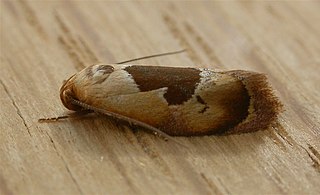
Hoplomorpha camelaea is a moth in the family Oecophoridae first described by Edward Meyrick in 1888. It is found in Australia, where it has been recorded from Victoria, Queensland, New South Wales and the Australian Capital Territory.

Izatha apodoxa is a moth of the family Oecophoridae. It is endemic to New Zealand, where it is known from scattered localities in the southern North Island. This species is variable in appearance and comes in two forms, a grey form and a black and white form. In the grey form it is very similar in appearance to I. notodoxa and in the black and white form to I. katadiktya. At present the larvae and biology of this species is unknown.

Izatha metadelta is a moth of the family Oecophoridae. It is endemic to New Zealand, where it is known from the North Island only. It is rare north of Waikato and the Bay of Plenty.

Izatha prasophyta is a moth of the family Oecophoridae. It is endemic to New Zealand, where it is known from the North Island, except Hawkes Bay or the Wairarapa. Larvae likely feed on rotting wood although larvae of this species have been reared on the fruiting body of the bracket fungus Bjerkandera adusta. Adults are on the wing from November to February.

Heterocrossa gonosemana is a species of moth in the family Carposinidae. It is endemic to New Zealand.

Ichneutica omoplaca is a moth of the family Noctuidae. It is endemic to New Zealand. It is widespread from the Bay of Plenty in the North Island down to Southland in the South Island. Specimens have also been collected from the Auckland Islands. It lives in a variety of habitats including beech forest clearings and tussock grasslands. This species has been recorded that some of the larval hosts of this species include Poa cita, Dactylis glomerata and it has been reared on Plantago lanceolata. The larva is undescribed but pupae have been found in a pine plantation in soil under weeds. Adults of this species are on the wing from October to March. The adult moths are variable in appearance but the diagnostic feature is the pale ochreous to white colouring between the basal streak and the costa which contrasts with the ground colour of the forewing.

Scoparia encapna is a moth of the family Crambidae. It was described by Edward Meyrick in 1888. It is endemic to New Zealand.

Scoparia petrina is a species of moth in the family Crambidae. It was named by Edward Meyrick in 1884. Meyrick gave a description of the species in 1885. It is endemic to New Zealand.
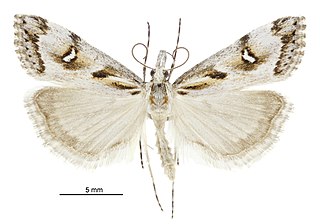
Gadira leucophthalma, the beaked moss moth, is a moth in the family Crambidae. It is endemic to New Zealand. It is found in the south eastern side of the South Island down to Banks Peninsula. G. leucophthalma inhabits the foredunes of coastal areas. The larval host is unknown but it has been hypothesised that the larvae feed on moss. The adult moths are day flying although some specimens have been trapped at night via light traps. Adults are commonly on the wing from March to April. This species has been classified as Nationally Vulnerable by the Department of Conservation.
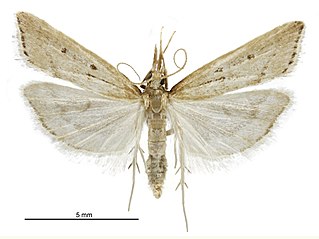
Antiscopa elaphra is a moth in the family Crambidae. It is endemic to New Zealand and has been observed in both the North and South Islands. Adults of this species are on the wing from August until March and are attracted to light. In 2020 this species had its DNA barcode sequenced.

Eudonia asterisca is a moth in the family Crambidae. It was named by Edward Meyrick in 1884 and is endemic to New Zealand. It has been recorded in both the North and South Islands. This species is recorded as being present at sea level up to altitudes of 1350 m. This species has been recorded as inhabiting native podocarp/hardwood forests. The adults of this species are on the wing from December until March although they have also been recorded in October and November. They are attracted to light and have also been trapped via sugar traps.

Eudonia psammitis is a moth in the family Crambidae. It was named by Edward Meyrick in 1884. Meyrick gives a description of the species in 1885. It is endemic to New Zealand, including the Campbell Islands.

Eudonia hemiplaca is a moth in the family Crambidae. It was described by Edward Meyrick in 1899. It is endemic to New Zealand.
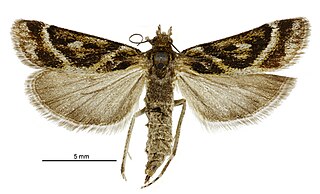
Eudonia xysmatias is a moth in the family Crambidae. It was first described by Edward Meyrick in 1907. This species is endemic to New Zealand and has been observed and collected in Otago. This species inhabits wetlands. Adults are day flying and are on the wing in December and January.
Scoparia chiasta is a moth in the family Crambidae. It was described by Edward Meyrick in 1885. It is found in Australia, where it has been recorded from New South Wales.
Mnesictena pantheropa is a moth in the family Crambidae. It was described by Edward Meyrick in 1884. It is endemic to New Zealand, where it has been recorded from the Chatham Islands.
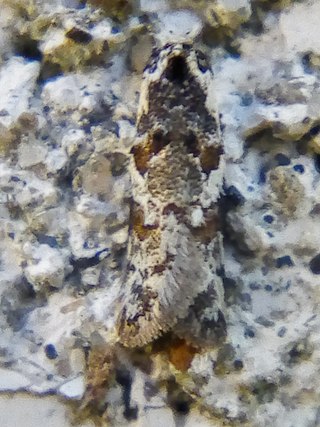
Trachypepla galaxias is a moth of the family Oecophoridae first described by Edward Meyrick in 1883. It is endemic to New Zealand and can be found throughout the country. This species inhabits native forest. The life history of this species is currently unknown. Adults are on the wing from October to February, are nocturnal and are attracted to light.

Trachypepla lichenodes is a moth of the family Oecophoridae first described by Edward Meyrick in 1883. It is endemic to New Zealand and has been found in both the North and South Islands. It inhabits native forest and adults of this species are on the wing from November to January. The adult moths are similarly coloured to native lichen species however this colouration is variable in the extent and depth on the forewings.

Trachypepla photinella is a moth of the family Oecophoridae first described by Edward Meyrick in 1883. It is endemic to New Zealand and has been collected in Wellington, Wainuiomata, D'Urville Island and Christchurch. The preferred habitat of this species is native forest and adults are on the wing from December until February.

Trachypepla protochlora is a moth of the family Oecophoridae first described by Edward Meyrick in 1883. It is endemic to New Zealand and is found in both the North and South Islands. The preferred habitat of this species is native forest and adults are on the wing from October until February. Adults can be variable in their green shaded colour as well as in the intensity of markings on their forewings. The greenish ground colouration of this moth ensures they are well camouflaged when at rest on green mosses and lichens.

















